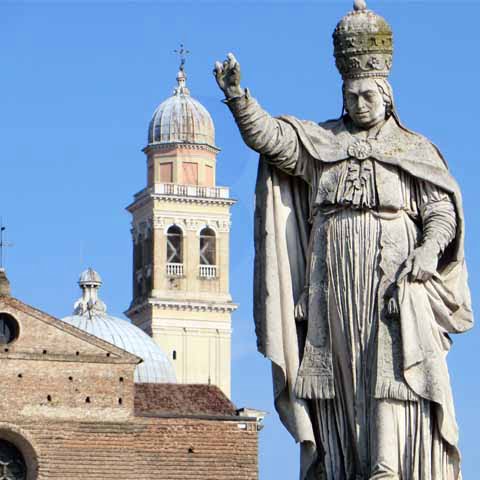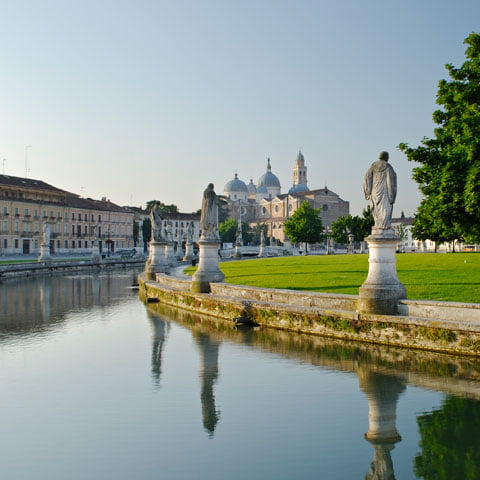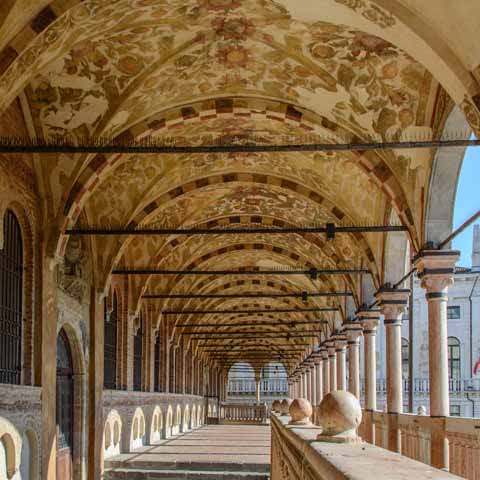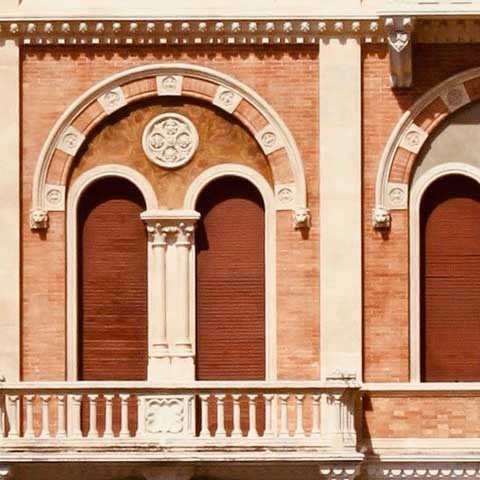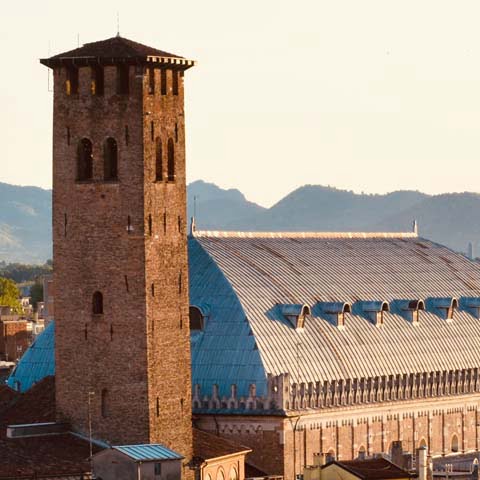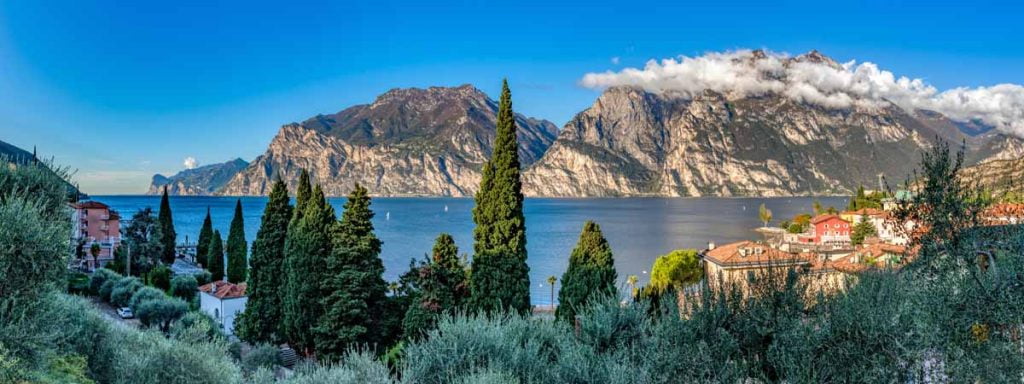According to local legends, the city of Padova, known as Padua in English, was founded in the year 1183 BC by the Trojan Prince Antenor. It is said that after the fall of Troy, Antenor led a surviving group of Trojans, along with their allies the Veneti, to a new land in the Euganean plain, which would come to be known as the Veneto plains. Legends say that Antenor banished the local Euganeans and established the city of Padova. According to the local citizens, his sarcophagus was discovered in 1274, but archaeologists are skeptical and believe that the sarcophagus in question may only date back to the third or fourth century BC.
Like most of the ancient cities in Italy, the city of Padova changed hands many times throughout history. After fending off invasions from the Spartans near the turn of the third Century BC, the city of Padova willingly joined into an alliance with Rome around 226 BC against the likes of the Gauls and the Carthiginians before fully assimilating into the Empire sometime during the second century BC as Rome spread its influence northward. Padova was particularly important to the Roman Empire, as the people of Padova were known for breeding some of the best horses and sheep in all of Italy. Padovan wool was heavily prized in the Roman Empire for being of exceptionally high quality, and tunics made from the wool were said to be particularly thick and comfortable against the chill of the northern winters.
As the Roman Empire started to decline, Padova was subjected to numerous attacks by the Huns, before finally falling under the control of the Goths in the fifth century. It was briefly reclaimed by the Byzantine Empire in the sixth century, but then fell under the control of the Lombards in 568, who went on to sack and burn the city when the Paduans attempted to rebel. Weakened by the attack, the Paduans were unable to fight back when the Franks came along to take the city from the Lombards.
Under Frankish control, Padova was effectively ignored and left to its own devices. This was both a blessing and a curse as the people of Padova began to reclaim a cultural identity, but it also opened them to further attacks from invading forces. In 899, the Magyars raided the city, ravaging it utterly. It would be years before Padova would begin to recover from these attacks. The time that Padova had to establish its own cultural identity, though would eventually lead to Padova achieving a semblance of independence in the eleventh century, as the citizens created their own constitution and legislative assembly. They would begin to engage in skirmishes with Venice and Vicenza for waterway rights, only for another fire to devastate the city in 1174, forcing the people of the city to rebuild yet again.
The people of Padova elected a member of the Este family as their Podestà in 1178 in an attempt to protect themselves from the growing Holy Roman Empire to the north. Around this time, in the year 1222, the University of Padua was established, which revived interest in classical study and the practices of law and science. Unfortunately, they failed to repel the invaders and in 1236 the city fell under the control of Ezzelino III da Romano, a vicar of Frederick II, who practiced terrible cruelties on the civilians until he was unseated in 1256 thanks to the aid of Pope Alexander IV.
Padova came under the control of the Venetian territories in 1405, and remained threatened by the Holy Roman Empire for years, changing hands and falling under opposing forces several times as skirmishes between various factions continued. When the Venetian Republic dissolved in 1797, Padova was traded to the Habsburgs, then again to France’s puppet Kingdom of Italy under the control of Napoleon Bonaparte in 1806. In 1814, with the fall of Napoleon, it was traded to the Austrian Empire. Finally, in 1866, during the Italian Unification, Padova officially became part of the new Kingdom of Italy, and has remained a part of Italy to this day.
ART
Like many cities in Italy, Padova has no shortage of astounding art for visitors to marvel at. Perhaps the most famous artistic site in Padova is the Scrovegni Chapel, which might seem simplistic and unremarkable when viewed from the outside. A single step inside, however, reveals one of the most historically relevant pieces of art history in all of Italy. The interior is painted wall to wall with beautiful frescoes by the medieval artist Giotto di Bondone, known more famously as simply ‘Giotto,’ between 1303 and 1305. The frescoes depict snapshots from the lives of Christ and the Virgin Mary, as well as an interpretation of the last judgment. After undergoing extensive restorations during the nineteenth and twentieth centuries, the frescoes, which are considered to be one of the most important examples of Western art, are now admired by travelers from all over the world each year.
The Scrovegni Chapel is merely the most famous of many different locations scattered throughout Padova that feature stunning works of art. Padova is filled with almost innumerable churches and museums and galleries home to religious and historical artwork. Among these sites are the Church of the Eremitani, which contains frescoes that managed to survive Allied bombing runs in World War II, and the Duomo di Padova which contains a stunning collage of frescoes and statues by the Renaissance artist Giusto de’ Menabuoi. There is also the Abbey of Santa Giustina which contains entire galleries full of paintings, sculptures, and other religious artifacts dating back to the tenth century and beyond.
Another remarkable chapel found in the city of Verona is the Oratory of Saint Michael. The original structure, which dated back to the sixth and seventh centuries, was largely demolished during the nineteenth century. However, the surviving chapel is filled with breathtaking frescoes of the life of Mary by Jacopo da Verona.
Fabulous frescoes can also be admired in the Oratory of Saint Rocco. The sixteenth century oratory was built on the site of a former church cemetery. The draw here is the lower hall, which is covered with frescoes depicting the life of Saint Rocco by artists such as Domenico Campagnola and Girolamo Tessari.
Padova also plays host to several museums that contain impressive art galleries of their own. These museums include the likes of the Villa Pisani at Stra, or the Villa Pisani National Museum, located on the outskirts of the Padova area. This massive villa-turned-national museum often holds exhibitions of ancient, classical, modern, and even contemporary art.
Another important museum is Museo d’arte medievale e moderna, or the Museum of Medieval and Modern Art. The museum traces Veneto’s artistic history from the fourteenth century to the eighteenth century with plenty of beautiful paintings and sculptures to admire. On display are works by Giovanni Bellini and Titian as well as artists from the Veneto region and international artists, particularly from the Flemish school of painting.
ARCHITECTURE
Perhaps the most important examples of architecture in Padova are the two Basilicas. Even from the outside, both the Basilica of Santa Giustina and the Basilica of Sant’Antonio are massive and impressive works of architecture. But the Basilica of Sant’Antonio in particular is notable for employing an impressive blend of multiple architectural styles, including Romanesque, Byzantine, Renaissance, Gothic, and Baroque. The massive altars of the basilica contain bronze sculptures by the Renaissance artist Donatello, depicting figures such as Christ with the Virgin Mary and Saint Anthony himself. Similarly, the Basilica of Santa Giustina is renowned for its blending of Romanesque, Gothic, Renaissance, and Baroque styles as well as artwork by Paolo Veronese and Luca Giordano, and reliquaries of Saint Luke the Evangelist, Saint Matthias, and Saint Justina.
Other architectural marvels found around Padova include the aforementioned Villa Pisani, which is an incredible example of late-Baroque architecture by the architects Girolamo Frigimelica Roberti and Francesco Maria Preti. Also worth noting in Padova is the Palazzo della Ragione. This medieval civic building contains an absolutely enormous main hall known as the Salone, covered by a massive, single roof designed by medieval architect Fra Giovanni Giocondo. Like many buildings in Padova, the walls are covered with frescoes, in this case painted by the artists Giovanni Nicolò Miretto and Stefano da Ferrara.
One of the most important examples of Renaissance architecture in Padova is the Cornaro complex, which features the Loggia and Odeo Cornaro. These two structures are what remains of a larger complex that featured additional buildings and gardens designed by Alvise Cornaro for theatrical and musical performances. Today, the buildings are part of Padova’s civic museums.
Located in Piazza dei Signori is a remarkable architectural feat that has become a symbol of the city. Torre dell’Orologio is an impressive clocktower that was constructed during the fifteenth century. In addition to the clock, the tower features a triumphal arch constructed in Istrian stone.
Padova was also the birthplace of the famed Italian architect Andrea Palladio, who designed villas all across the Veneto region, and whose style was copied well into the eighteenth and nineteenth centuries.
SCIENCE
Throughout its long history, Padova has been a center of scientific advancement and development. The number of famous scientific minds that have studied or taught at the University of Padova is almost too many to count. Some of the more esteemed members of the university over the years include Copernicus, Gabriel Fallopius, Andreas Vesalius, William Harvey, and Galileo Galilei. Since the founding of the university, Padova has served as a center for mathematics, astronomy, and medicine.
Those interested in astronomy should be sure to visit the Museo dell’Osservatorio Astronomico, or the Museum of the Astronomical Observatory. This medieval tower-turned-observatory served as a spot for astronomers of days gone by to observe the heavens and study the movements of stars and planets. Today, it is a way for curious visitors to learn how scientists of the past conducted their research, allowing visitors a look at the old scientific instruments they used.
Perhaps even more important is Padova’s history of medicine, though. To this day, one can visit the University of Padua and catch sight of the oldest anatomical theater in the world. Visitors can also take a trip to MUSME, also known as the Museo di Storia della Medicina, or the Museum of the History of Medicine. Here, one can study the human body through videos, interactive displays, and many hands-on exhibits that facilitate tactile learning and engagement.
Finally, visitors to Padova should not miss out on the Botanical Gardens at the university. The Orto Botanico is the oldest botanical garden in existence and began the practice of housing plants for study and public viewing. Today, it is a UNESCO World Heritage Site and houses a wide variety of medicinal and poisonous plants, as well as an impressive array of carnivorous plants.
LITTERATURE
While not quite as prominent as its history of scientists and mathematicians, Padova’s university has also played host to its fair share of poets and literary scholars. Among the most prominent members of the university are the likes of Pietro Bembo, a poet and literary theorist who helped to develop the Italian language as a literary medium by cataloguing and categorizing it for modern script. Also coming out of the university was Sperone Speroni degli Alvarotti, who wrote about the principles of theater, as well as philosophical, humanist, and moral issues, and Torquato Tasso, a revered sixteenth century Italian poet who wrote the epic Gerusalemme liberata about the Siege of Jerusalem during the first Crusade.
Padova has also served as the setting for numerous plays and books over the centuries, with the most notable being Shakespeare’s The Taming of the Shrew. Other examples include Angelo, Tyrant of Padua by Victor Hugo, The Charterhouse of Parma by Stendhal, The Duchess of Padua by Oscar Wilde, Life of Galileo by Bertolt Brecht, and Rappaccini’s Daughter by Nathaniel Hawthorne.
CINEMA
As with literature, the charming city of Padova has served as inspiration for Italian and international filmmakers over the decades. Examples of films set in Padova, either fully or in part, include Hot Enough for June (1965), The Taming of the Shrew (1967), La moglie del prete (1970), Gli ordini sono ordini (1972), Il gatto dagli occhi di giada (1977), Delitti e profumi (1988), Viaggi di nozze (1995), I piccoli maestri (1997), La lingua del santo (2000), Ripley’s Game (2002), La giusta distanza (2007), and Sole a catinelle (2013).
MUSIC
Lovers of classical music and opera who come to visit Padova should be sure to visit the Teatro Verdi. This theater and opera house hosts many operas, plays, musicals, and ballets each year. Fans of more modern styles of music need not fret, however, as the Teatro Verdi also hosts concerts featuring more modern music as well. The Teatro Verdi hosts events most days out of the year.
The city of Padova has a rich history of serving as one of the Veneto region’s cultural and scientific hubs. Internationally renowned as the setting for Shakespeare’s The Taming of the Shrew and for its ties to St. Anthony, Padova is a city full of beautiful basilicas and legendary art just waiting to be discovered.
Don't just see Italy, live it.
Your dream trip to Italy has never been closer
No more endlessly scrolling travel sites. Our travel experts will craft the perfect, one-of-a-kind trip just for you.

300+
DESTINATIONS
We offer more Italian destinations than any travel site. Do and see more with Trips 2 Italy.
1 (of a kind)
ITINERARIES
Because your dream trip to Italy should be designed for you, not for the masses.
100%
PEACE OF MIND
From flights and accommodations, to food and activities - we take care of every detail.
